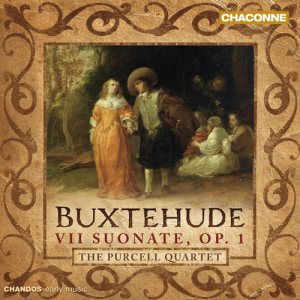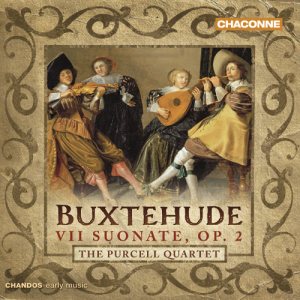 |
 |
| 

alternatively
CD: MDT
AmazonUK
AmazonUS
Sound
Samples & Downloads |
Dieterich BUXTEHUDE
(1637 - 1707)
VII Suonate, op. 1
Sonata I in F, op. 1,1 (BuxWV 252)** [8:47]
Sonata II in G, op. 1,2 (BuxWV 253)** [7:47]
Sonata III in a minor, op. 1,3 (BuxWV 254)* [8:54]
Sonata IV in B flat, op. 1,4 (BuxWV 255)* [8:02]
Sonata V in C, op. 1,5 (BuxWV 256)** [8:13]
Sonata VI in d minor, op. 1,6 (BuxWV 257)* [7:47]
Sonata VII in e minor, op. 1,7 (BuxWV 258)** [6:42]
 The Purcell Quartet (Catherine Mackintosh*, Catherine Weiss** (violin),
Richard Boothby (viola da gamba), Robert Woolley (harpsichord))
The Purcell Quartet (Catherine Mackintosh*, Catherine Weiss** (violin),
Richard Boothby (viola da gamba), Robert Woolley (harpsichord))
rec. 26 - 27 November 2008, 5 January 2009, Church of St Bartholomew,
Orford, Suffolk. DDD
 CHANDOS CHAN 0766 [56:53]
CHANDOS CHAN 0766 [56:53]
|


alternatively
CD: MDT
AmazonUK
AmazonUS
Sound
Samples & Downloads |
Dieterich BUXTEHUDE
(1637 - 1707)
VII Suonate, op. 2
Sonata
I in B flat, op. 2,1 (BuxWV 259)* [7:24]
Sonata II in
D, op. 2,2 (BuxWV 260)* [11:56]
Sonata III in g minor,
op. 2,3 (BuxWV 261)** [10:35]
Sonata IV in c minor, op.
2,4 (BuxWV 262)* [7:11]
Sonata V in A, op. 2,5 (BuxWV
263)* [8:45]
Sonata VI in E, op. 2,6 (BuxWV 264)** [9:17]
Sonata VII in F, op. 2,7 (BuxWV 265)** [7:41]
 The Purcell Quartet (Catherine Mackintosh*, Catherine Weiss** (violin),
Richard Boothby (viola da gamba), Robert Woolley (harpsichord))
The Purcell Quartet (Catherine Mackintosh*, Catherine Weiss** (violin),
Richard Boothby (viola da gamba), Robert Woolley (harpsichord))
rec. 21 - 23 February 2011, All Saints' Church, East Finchley, London,
UK. DDD
 CHANDOS CHAN 0784 [62:55]
CHANDOS CHAN 0784 [62:55] |
| |
Dieterich Buxtehude's chambre music comprises two collections
of seven sonatas each, printed as op. 1 and op. 2 respectively,
and eight sonatas which have been preserved in manuscript. The
latter are in different scorings: one or two violins - with
or without viola da gamba - or viola da gamba solo, all with
basso continuo. The two printed collections only include sonatas
of the scoring which was particularly popular in northern Germany:
violin, viola da gamba and bc. These were printed in about 1694
and 1696 respectively but were not the first sonatas by Buxtehude.
In 1684 the publication of another collection was advertised,
but this has never been found. It is impossible to say whether
it has been lost or perhaps never printed. The title is interesting
because of the reference to its use for the church and the 'table',
the latter meaning that they could be played during dinner.
It is reasonable to assume that the sonatas op. 1 and op. 2
were written with the same purpose in mind.
The sonatas may have been played by the members of the Ratsmusik
in Lübeck, an ensemble of highly skilled and versatile
musicians. They played at official events, but also in the private
homes of wealthy citizens, and participated in the Abendmusiken
which took place in the Advent period. Another possibility is
that Buxtehude himself played his sonatas with his colleagues
and friends from Hamburg, Johann Theile and Johann Adam Reinken.
The sonatas have no fixed form; they consist rather of a variable
number of sections of varied length, character and metre. Quick
succession of contrasting sections is one of the features of
the stylus phantasticus which had its roots in Italian
music of the early 17th century and left its mark not only on
music for instrumental ensemble but also on keyboard works.
The German theorist Johann Mattheson stated that "this style
is the most free and unrestrained manner of composing, singing,
and playing that one can imagine, for one hits first on this
idea and then upon that one, since one is bound neither to words
nor to melody, only to harmony, so that the singer and player
can display his skill".
It is of vital importance to realise this character of the chamber
music from northern Germany of the 17th century. Another important
aspect is that there was a close connection between speech and
music. German theorists of the 17th century compare musicians
with orators. A composition had to follow the rules of rhetoric
in its structure and organisation of material. Obviously performers
need to be aware of this in order to do justice to the character
of a composition. This means that the performance should be
speech-like, as an instrumental translation of the early baroque
ideal of recitar cantando.
It is exactly in this department that the interpretations of
The Purcell Quartet fail to convince. The first disc is neatly
played but rather dull. The sonatas are quite dramatic thanks
to the quick succession of contrasting sections but the contrasts
are severely underexposed. That is also due to the fact that
the tempi are too moderate: the fast sections are mostly too
slow, the slow sections not slow enough. Dynamically the playing
is as flat as a pancake. There is also too little differentiation
between stressed and unstressed notes. The performances are
slightly better at the second disc: the contrasts are stronger
and the instruments also have more presence. The latter could
in part be down to the recording.
Even so, in the end these two discs are rather disappointing.
Buxtehude's music is much more dramatic and exciting than the
interpretations of The Purcell Quartet suggest. The recording
of these two collections by L'Estravagante (here) is a much better choice.
Johan van Veen
http://www.musica-dei-donum.org
https://twitter.com/johanvanveen
see also review by Byzantion
of CHAN0784
|
|

